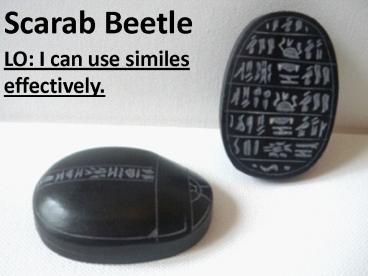Scarab Beetle - PowerPoint PPT Presentation
1 / 9
Title:
Scarab Beetle
Description:
Scarab Beetle LO: I can use similes effectively. Vocabulary/Glossary: scarab: a symbol of the sun god often made into amulets and shaped like the dung beetle. – PowerPoint PPT presentation
Number of Views:747
Avg rating:3.0/5.0
Title: Scarab Beetle
1
Scarab Beetle
LO I can use similes effectively.
2
Vocabulary/Glossary scarab a symbol of the sun
god often made into amulets and shaped like the
dung beetle. amulet an object that provides
protection. hieroglyphs the writing system of
ancient Egypt that used pictures and symbols
instead of an alphabet. larva an early stage of
growth for some insects after hatching from their
egg when they often look like worms. Afterlife
the life ancient Egyptians expected after
death. Khepri a god of creation, the movement of
the sun, and rebirth. solar of the sun.
3
Context You are a poet and you have been asked
to create a poem that is based on the Heart
Scarab as amulet, as creature and as myth. It
should inspire the Y2 children to find out about
ancient Egyptian artefacts. It should have
three verses.
4
Explanation The Heart Scarab Amulets Scarab is
a term used to refer to a popular symbol of the
sun god in ancient Egypt. Scarab-shaped beads
were used in jewellery such as rings and
necklaces. The Heart Scarab was a powerful amulet
that Egyptians often buried with the dead. In
general, Heart Scarabs were larger than regular
scarabs and were made of dark green stone.
Hieroglyphs were inscribed on the bottom with
instructions for the heart of the dead person.
Heart Scarabs were placed on the chest of the
mummy during the wrapping or sometimes inside the
body. The heart scarab could replace the heart
of the dead if it was lost or damaged. The
scarab also could protect the real heart and aid
it by stopping it from speaking against the
person at the weighing of the heart judgement in
the Afterlife.
5
The Heart Scarab The Creature The species of
beetle represented by the scarab is the
Scarabaeus sacer or dung beetle. This beetle
feeds on animal dung. It makes the dung into
balls and rolls them away to feed, often in a
hole in the ground. Beetles frequently fight
over dung balls and steal them from each other.
Dung beetles also make pear-shaped balls of dung
underground in which to lay eggs. The young
beetle larvae feed on the dung until they are
ready to come out of the ground as full-grown
beetles.
6
The Heart Scarab The Myth The behaviour of the
dung beetle reminded the Egyptians of the
behaviour of the sun. The sight of the dung
beetle rolling its ball of dung reminded the
Egyptians of how the sun moves across the sky.
The sight of full-grown beetles coming out of the
ground reminded the Egyptians of the sun rising,
the creation of the world, and the rebirth of the
dead. In myth, the sun had to battle against
evil forces to succeed after passing through the
sky on earth and then into the Afterlife during
night on earth. The Egyptian god connected to
the dung beetle was named Khepri, which is the
ancient Egyptian word for 'to become'. Khepri
was a solar god with a special role as a creator.
Sometimes Egyptians drew Khepri as a scarab
pushing the sun across the sky, while at other
times they drew him as a man with a scarab beetle
for a head.
7
Explore Heart scarab artefact What does it feel
like? (texture, temperature) What does it look
like? (colour, size, shape) Pass around the
Heart Scarab. Your task will be to write a
similes poem about the Heart Scarab. Discuss
what a simile is, and write up some examples,
with reference to the Heart Scarab. E.g. Your
skin is as cold as ice. E.g. You are smooth like
silk.
8
Task Write a similes poem about the Heart
Scarab.
Verse 1 The Heart Scarab The Amulet
You are as cold as...
You are as shiny as...
You are as hard as...
You are as smooth as...
Verse 2 The Heart Scarab The Creature
You roll balls of dung like...
You push the dung down like...
Your young eat the dung hungrily like...
Your young emerge from the earth like...
Verse 3 The Heart Scarab The Myth
Your antennae are like...
You move the sun across the sky like...
You push the sun into the underworld which is as scary as...
You make the sun rise again each day which makes me as happy as...
Success Criteria adjectives in each line (E.g.
frozen) powerful verb in each line (E.g.
howl). include adverbs (E.g. greedily).
9
Plenary Share the poems with the class. Review
Success Criteria. Choose poets to share their
poems with Y2.































